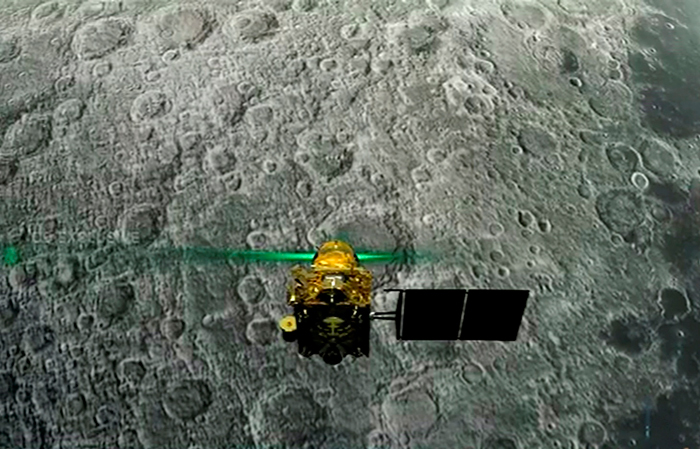India’s space agency on Saturday suggested it might still be possible to regain contact with the Chandrayaan-2 lander, which had fallen silent just before touchdown, and described the moon mission as “90 to 95 per cent” successful despite the last-minute snag.
Indian Space Research Organisation chairman K. Sivan said the Chandrayaan-2 ground station would keep looking for signals from the lander, Vikram, till the end of its lifespan of one lunar day or 14 earth days.
“We will be trying to (re)establish a link. For the next 14 days we will try. If at all we succeed, we will operate the payloads and get data,” he said.
Isro was heading for the moment of its biggest triumph early on Saturday when it suffered the heartbreak of losing contact with Vikram, 2.1km above the moon’s surface and minutes before the scheduled soft-landing.
The lander was then in the third of a four-phase, 15-minute landing sequence ahead of an expected 1.53am touchdown.
A successful moon landing would have made India the fourth member of an elite club that includes the former Soviet Union, America and China — and the first country to probe the unexplored lunar south pole and look for water ice under its surface.
While the fate of Vikram and an onboard rover named Pragyan remains unknown, Isro has said the mission’s other component, the orbiter which carries eight instruments to study the lunar surface and its exosphere, is working well.
Space experts say Isro is likely to use the cameras aboard the orbiter to ascertain the fate of Vikram as well as seek information from other space agencies.
Even in the worst-case scenario, the orbiter will continue to provide valuable data on the possible presence of water ice on the lunar south pole, Sivan said.
An Isro statement said the 46-day-old mission had accomplished “90 to 95 per cent” of its objectives. “The success criteria (were) defined for each and every phase… and till date 90 to 95 per cent of the mission objectives have been accomplished,” it said.
Sivan said: “Chandrayaan-2 had two objectives. One was science; the other was a technology demonstration. The science part was the orbiter while the technology demonstrator was the lander-rover.
“Our orbiter is going round the moon in the polar orbit. Using this data we can do a lot of research on the polar region. That will be the first time such data would be available to the global community.”
Sivan said the orbiter had a designated lifespan of one year but could now last “7.5 years” with the fuel it had saved. (The orbiter can now eschew the complicated manoeuvres it would have needed to perform to catch the signals from an active lander.)
Prime Minister Narendra Modi was among the audience invited to watch Vikram’s descent live from Isro’s mission control centre in Bangalore. But the claps and smiles from the engineers that had punctuated the successful completion of the first two phases of the lander’s descent soon died down.
The lander had been in an autonomous mode when contact was lost. “I can think of two possibilities: the lander crashed or the autonomous mode allowed it to land but it lost communication capabilities,” said Chockalingam Valliappa, an engineer and head of a team at the Sona College of Technology, Salem, that provided fuel-mixing motors and a laser instrument for Vikram’s descent.
The descent, powered by four rocket thrusters, was intended to slow Vikram’s speed from 1,640 metres per second (about 5,900km per hour) at an altitude of 30km above the lunar surface to zero metres per second at about 400 metres above the moon, and then make it descend vertically for a touchdown.
All appeared to be going well during the “rough breaking phase” and the “altitude and navigation control phase”. At nine minutes and 48 seconds into its descent, the lander’s horizontal velocity had dropped to 298 metres per second (about 1,072km per hour) and its vertical velocity was about 73 metres per second.
At an altitude of about 5km above the lunar surface, the lander entered its third phase – the “fine breaking phase” -– intended to slow it to zero horizontal velocity. Information available from Isro so far suggests that something went wrong during this phase.
Space experts said that loss of communication was a problem that Isro and other space agencies had encountered in the past too. Isro had last year lost communication links with its GSAT-6A telecommunications satellite within three days of its launch.
Sivan said Saturday’s setback would have no bearing on Isro’s future programmes, including its first human space flight, the Gaganyaan, planned for December 2021.











